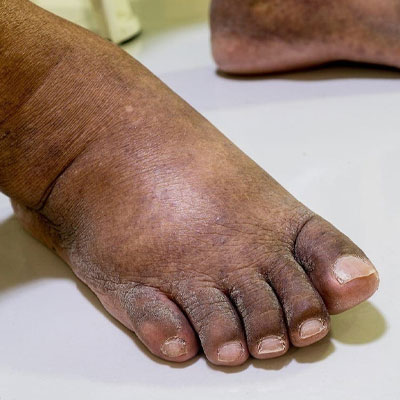What is Diabetic Foot Treatment?
Diabetic foot treatment is a specialized medical approach to managing foot complications caused by diabetes. People with diabetes are at high risk of developing foot-related problems due to poor circulation, nerve damage (neuropathy), and an increased likelihood of infections. Without timely intervention, these conditions can lead to severe complications, including ulcers, gangrene, and even amputation
Diabetic foot treatment includes both surgical and non-surgical approaches aimed at preventing, managing, and treating foot ulcers, infections, and deformities. A comprehensive treatment plan helps reduce complications and improve mobility and quality of life for diabetic patients
What are the Services for Diabetic Foot Treatment?
Surgical Diabetic Foot Care
Surgical diabetic foot care focuses on treating severe infections, ulcers, or deformities that cannot be managed with conservative treatments. Some of the common surgical interventions include
Debridement of Infected Tissues
Debridement is a surgical procedure that removes dead or infected tissues from foot ulcers. This helps in promoting healing, reducing infection, and preventing further tissue damage
Drainage of Abscesses
Diabetic foot infections often lead to abscess formation. Surgical drainage is necessary to remove pus and reduce the risk of spreading infections to deeper tissues
Revascularization Surgery
Poor circulation is a common issue in diabetic foot conditions. Revascularization surgery restores blood flow to the affected foot by bypassing or clearing blocked arteries, improving wound healing and reducing the risk of amputation
Amputation (When Necessary)
In severe cases where gangrene or untreatable infections have spread extensively, partial or total foot amputation may be required to prevent life-threatening complications
Non-Surgical Diabetic Foot Care
For patients with mild to moderate diabetic foot issues, non-surgical treatments help manage symptoms and prevent complications
Wound Care and Ulcer Management
Diabetic foot ulcers require specialized dressings and medications to prevent infection and promote healing. Regular cleaning and monitoring of wounds are essential to avoid severe infections
Offloading Techniques
Pressure on an ulcerated or infected foot area can worsen the condition. Offloading methods such as crutches, specialized footwear, or casts help reduce pressure and allow the foot to heal
Antibiotic Therapy
Bacterial infections are common in diabetic foot conditions. Oral or intravenous antibiotics are prescribed to control infections and prevent their spread
Glycemic Control
Proper diabetes management, including blood sugar control through diet, medication, and insulin therapy, plays a crucial role in preventing diabetic foot complications
Corrective Surgery for Diabetic Foot
Corrective surgery is performed to address deformities or abnormalities that increase the risk of foot ulcers and infections. Some of the common corrective procedures include
Charcot Foot Reconstruction
Charcot foot is a severe diabetic complication that causes joint damage and foot deformities. Surgery helps stabilize and reconstruct the foot to restore its function
Tendon Lengthening Procedures
Patients with tight tendons or muscle imbalances may develop foot ulcers due to abnormal pressure distribution. Tendon lengthening procedures improve foot mobility and reduce the risk of recurrent ulcers
Bone Resection Surgery
In some cases, removing a portion of the bone can help relieve pressure points and prevent chronic wounds in diabetic patients
Footwear and Prosthetics for Diabetic Foot
Proper footwear and prosthetics play a crucial role in preventing diabetic foot complications
Diabetic Footwear
Customized diabetic shoes provide extra cushioning and support, reducing pressure points and preventing foot ulcers. These shoes also help in evenly distributing body weight to avoid excessive stress on any part of the foot
Orthotic Insoles
Specialized insoles help correct foot alignment and provide additional support to reduce strain on sensitive areas
Prosthetics for Amputees
For patients who have undergone foot or leg amputation, prosthetics restore mobility and improve their quality of life. Modern prosthetic designs focus on comfort, stability, and functionality
Pratap Hospital – Specialized Diabetic Foot Treatment
Pratap Hospital is a leading healthcare facility offering expert diabetic foot treatment. The hospital specializes in both surgical and non-surgical care, focusing on wound management, infection control, and corrective procedures to prevent amputations.
The hospital is equipped with advanced medical technology and a team of specialists who provide comprehensive diabetic foot care. Patients receive personalized treatment plans to address their specific conditions, ensuring optimal healing and improved mobility
Dr. Pratap Duggirala – Best Diabetic Foot Treatment Doctor in Vijayawada, Andhra Pradesh
Dr. Pratap Duggirala is a highly experienced doctor specializing in diabetic foot treatment. With years of expertise in managing diabetic foot complications, he provides advanced care, including wound management, infection control, and corrective surgeries
His patient-centric approach and commitment to excellence make him one of the best diabetic foot treatment doctors in Vijayawada, Andhra Pradesh. Patients trust his expertise in preventing amputations and ensuring effective foot care for individuals with diabetes
Diabetic foot treatment is essential for preventing severe complications in individuals with diabetes. A combination of surgical and non-surgical approaches ensures effective management of foot ulcers, infections, and deformities. Specialized care from experts like Dr. Pratap Duggirala at Pratap Hospital provides the best outcomes for diabetic foot patients
Early diagnosis and proper foot care can significantly reduce the risk of amputation and improve the quality of life for diabetic individuals. If you have diabetes, regular foot check-ups and preventive care should be a priority to maintain foot health and mobility

